FW
There is a surge in the demand for vegan-friendly clothing and footwear in the UK. More and more brands, retailers and apparel and footwear companies want to be seen as embracing veganism. But many issues need to be considered before declaring products free from animal-derived materials or ingredients. Sourcing vegan fashion products goes further than simply bypassing wool, leather and natural silk as raw materials. Retailers must also take care to guard against the use of a number of dyes, glues and chemicals that are derived from animals. Materials used in the production of vegan products must be robust and maintain the qualities of the animal-based materials they are replacing.
Among the companies that have launched vegan products are Topshop, Asos and New Look, which last summer became the first high-street fashion retailer to register ranges with The Vegan Society’s Vegan Trademark. Building a relationship between internal sourcing and buying teams and suppliers is key in not only instilling confidence along the supply chain but among consumers too.
Veganism is increasingly becoming a lifestyle choice for many people, with the number of vegans in Great Britain quadrupling between 2014 and 2019. With this rise comes a likely surge in the demand for vegan- friendly clothing and footwear.
Tokyo Creative Salon will be held from March 15 to 31, 2020. This is Japan’s largest fashion and art event and the plan is to boost its case to become one of the world’s key fashion hubs. It will feature a variety of fashion and art initiatives across five key districts. Each district will present a line-up of exhibitions and activations such as street runways, art installations, dance performances and talk sessions.
Tokyo Creative Salon Nihonbashi will feature a theme, which advises visitors to turn off their mobile devices to fully experience the event. Some 10,000 Sacoche bags, which block smartphone reception, will be given out as gifts. The Nihonbashi venue will feature Sakura Menu Walk and Nihonbashi Art Gate where artists create works with the Nihonbashi (that is) unrecognisable by the smartphone theme. The event also features an exhibition Fun in the Life by Hobonichi, allowing people to experience Fun in the life through valuable shops and specially prepared products and food. A Ginza Rooftop Project will be held on the rooftops of several landmarks including Matsuya Ginza, Ginza Mitsukoshi, Wako and Tokyo Plaza Ginza. The district will also present other fashion shows and art installations. During the Tokyo Creative Salon at Daikanyama, visitors will get to try on vintage kimonos.
India’s new national textile policy will be out in a few months. The target will be to address structural issues and ensure basic raw materials are available at international prices, encourage scale of operation by developing ten mega textile parks closer to ports and give plug-and-play facilities, including the necessary safeguard measures in labor laws. Power cost and credit cost will be addressed. Efforts will be made to expedite free trade agreements with the EU, the UK and Bangladesh, along with other countries, to boost exports. The Tirupur garment cluster will be encouraged to brand garments and products under a sustainable program that will fetch it a larger margin. The surplus production capacities created across the value chain during the last four years will be utilised for polyester textile manufacturers.
The textile industry has been identified as a thrust area. As part of inclusive growth jobs will be provided at all skill levels especially the rural masses and women. Dedicated textile parks will be set up for technical textiles and textile machinery manufacturing with the latest technology spares, accessories and parts to promote import substitution and thereby reduce the capital cost substantially. R&D centers are envisaged for each segment.
India Trend Fair was held in Japan, February 12 to 14, 2020. The trade show showcased Indian-made clothing and accessories to Japanese buyers. The business matching event focused on knitted and woolen clothing as Japan is a major world market for wool, wool blended, and other textile products. The event featured over 300 product categories and over 25 pavilions. Around 500 buyers and over 2,500 visitors attended the event with an approximate mix of 79 per cent industry professionals and 21 per cent local consumers. A wide range of readymade garments and home textiles was on show with the aim of increasing exports to Japan through networking facilitated by the trade show. Participating Indian brands included Poornima Handicrafts, Roha and Velez, among others. Exporters got an opportunity to showcase their products and supply value added products with a special emphasis on products designed to suit Japanese fashion trends and requirements.
Japan is a sophisticated market, leaning towards small-lot and short cycle delivery of supply. Consumption is diversified and quality expectations are very high. High quality and expensive Indian garments are gaining popularity in Japan. Customers like selecting garments that have a different character when compared with dresses and kimono worn at such occasions as weddings and parties.
True, Victor and Teknit have come under North American leader for contract textiles Duvaltex. These three brands were already part of the Duvaltex group. By combining them, Duvaltex hopes to reinforce its position as the key brand and leader of commercial textile industry. Streamlining is also expected to lead to more sustainable solutions. In the first step of the migration, all the design services will be merged to achieve greater synergy. Clients will benefit from a simplified client experience, with the same responsive, customer-centric service and access to a wider range of resources. The strengths of each brand will now be available through a new, streamlined partnership that will give all Duvaltex customers access to a wealth of textile design and engineering talent.
As groundbreakers in sustainable development for over 20 years, Duvaltex has a unique approach focused on reusing discarded materials and reducing waste. Since 2000, the company has manufactured over a hundred million yards of sustainable fabrics made from materials diverted from landfills. In 2019, in its ongoing pursuit of an ever-smaller environmental footprint, the company launched an industry first - the 100 per cent post-consumer recycled biodegradable polyester. The company has always been guided by the desire to use resources responsibly.
The Ccoronavirus has hit luxury brands particularly hard as many of them rely on China as a significant source of business. The virus has impacted their business, not just on a logistical level, but in terms of sales. Burberry has already temporarily closed 24 of its 64 stores in China. Alibaba’s next quarterly financial earnings are expected to reflect a significant downturn because of the Coronavirus. And there could be more long-term effects on the horizon. Brands that don’t necessarily sell or manufacture in China could be affected if their core customer is a frequent traveler. Travel brands, airport retail and tourist destinations could all see an effect as more travel restrictions on who can enter and leave the country are put in place. More than 50 countries around the world, including the US, Italy and Australia, have restricted travel to and from China.
China will likely stay a major player in both manufacturing and consuming fashion once the virus has subsided. But brands are already reconsidering putting all their proverbial eggs in China’s basket due to the China-US trade war. This crisis may only exacerbate those feelings. In the long term, more retailers can be expected to spread production, sourcing and manufacturing across countries to avoid future risk.
Asia is the biggest stakeholder in the global garment manufacturing industry. Seven among the top 10 garment manufacturing countries are located in Asia. Fast fashion retailers depend on Asia for manufacturing their apparel products. This manufacturing hub is witnessing an immense transformation as global consumers are moving from cheap knitwear apparel products to value-added sportswear and manmade-synthetic fiber-based fashion products. Also, consumers now value garments with speed, precision, traceability and adaptability over bulk. Moreover, due to fast fashion, fashion seasons have shortened and garment brands are turning to manufacturers who have shorter production times and more sustainable processes. As a result, garment manufacturers in Asia are transforming themselves with technology.
Some garment brands are moving their smart factories from the West to Asia to improve manufacturing. For instance, Adidas has moved its speed factory to Asia to bring more efficiency to the manufacturing process. As Asian countries improve their capacity in tech manufacturing, garment manufacturing in Asia is expected to become smarter. Companies are investing in new technology to shorten lead time. They are now using automated cutting machines and self-driving carts as in-house innovations and high-speed fabric inspection machines with facial recognition technology to monitor thousands of meters of fabric a day.
"Bypassing Hong Kong, many brands are now making Shanghai or Beijing their first port of call. The city, which European and American brands identify with for its culture, language and shopping habits, has since long being known as a China-light launch pad. Its Causeway Bay and the malls of Central and Tsim Sha Tsui are packed with smaller labels that have little to no presence on the Mainland but hope Hong Kong might be their gateway to China’s shopping classes."
 Bypassing Hong Kong, many brands are now making Shanghai or Beijing their first port of call. The city, which European and American brands identify with for its culture, language and shopping habits, has since long being known as a China-light launch pad. Its Causeway Bay and the malls of Central and Tsim Sha Tsui are packed with smaller labels that have little to no presence on the Mainland but hope Hong Kong might be their gateway to China’s shopping classes.
Bypassing Hong Kong, many brands are now making Shanghai or Beijing their first port of call. The city, which European and American brands identify with for its culture, language and shopping habits, has since long being known as a China-light launch pad. Its Causeway Bay and the malls of Central and Tsim Sha Tsui are packed with smaller labels that have little to no presence on the Mainland but hope Hong Kong might be their gateway to China’s shopping classes.
With its numerous stores, Lane Crawford can ease some of the barriers to entry and import complications that foreign companies struggle with. However, the sharp drop in revenue that Hong Kong retailers have recorded due to months of violent anti-government protests, have scared away many high-end shoppers. Tourist visits plunged by around 50 per cent by late last year.
Closing of rail and sea links leads to decline in revenues
Compounding the problem, recent Coronavirus epidemic has led to the closure of a number of rail and sea links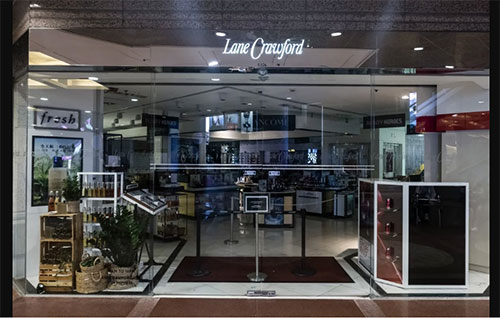 between Hong Kong and the Mainland further curtailing the mass flood of Chinese tourists who previously took advantage of lower apparel prices. As the recent decline in K-beauty brands’ average Baidu Index by 3 per cent in the second half of 2018 revealed, Chinese visitors to South Korea dropped to 4.8 million from 8 million in 2016 due to the THAAD (an anti-ballistic missile defence system) dispute.
between Hong Kong and the Mainland further curtailing the mass flood of Chinese tourists who previously took advantage of lower apparel prices. As the recent decline in K-beauty brands’ average Baidu Index by 3 per cent in the second half of 2018 revealed, Chinese visitors to South Korea dropped to 4.8 million from 8 million in 2016 due to the THAAD (an anti-ballistic missile defence system) dispute.
LVMH’s revenue in Hong Kong declined 40 per cent in Q4 of last year while Prada closed flagship stores in Causeway Bay due to Hong Kong’s anti-government protests.
Brands invest in locally relevant initiatives
However, these protests are not the only reason designers are taking Hong Kong out of their business plans. In order to reach Chinese consumers, brands are investing on locally relevant marketing initiatives. Smaller brands are partnering Chinese investors who can help them clear hurdles that once tripped up foreign designers. For example, US shoe brand Allbirds and London-based label Self-Portrait are planning to open stand-alone boutiques in Shanghai, Beijing and Chengdu, without testing Hong Kong waters first. Allbirds plans to launch more brick-and-mortar outlets in China that will focus on provincial capitals, as well as other first- and second-tier cities.
Shenzhen Ellassay Fashion, which owns a controlling stake in Vivienne Tam, acquired French brand Iro’s entire operations and the brand rights to American apparel brand Ed Hardy in China, among others. This would enable the company to expand its market share rapidly.
New e-com platforms for smaller brands
E-tailers are also setting up e-commerce platforms for smaller brands. The well established E-tailer Tmall platform has become an important incubator for emerging designers hoping to break into China. The platform offers brands that are new to the market support in multiple areas including promotions to build awareness, CRM [customer relationship management], data, and product development through the Tmall Innovation Centre.”
Though things are not easy in Mainland China either, many international brands are entering the country with local partners. This may soon cause Hong Kong to lose the distinction it once had as an entry to the country’s awe-inspiring spending power.
Garware Technical Fibres Ltd. (formerly Garware-Wall Ropes Ltd.), a leading solution provider of technical textiles for the Indian and global markets, held a press conference in Bhubaneswar on the success of Pentha Project which was completed within a span of 3 years (2013-2016) in Orissa.
The Pentha project was a pioneering project in Odisha to use soft intervention technology with 3 tiers of geo-textile tubes, for coastal protection. The Geo-textile tubes helped in withstanding the extremely severe cyclones (viz) ‘Phailin’ ,’Hud Hud’ and ‘Fani’ that hit the state of Odisha and its coastal neighbours . The geo-textile tube acts as a massive bund that can be used as a protective measure against tidal wave action due to cyclones or tsunamis. At the time of cyclone last year in the months of April 2019, the Pentha Village and the adjoining villages were not affected because of the existence of the Geosynthetics-Tubes.
The Chief Guest for this occasion was Shri Sujeet Kumar, Advisor, Special Development Council, and Government of Odisha who stated that coastal erosion was an important subject for the state of Odisha. The technical expertise was brought in by Prof Sundarvadivelu of IIT Madras, who had designed the project, and explained the complexities therein, in simple terms.
Sharing his view on the success of the Pentha Project, Mr. Tiru Kulkarni, President Geosynthetics Division Garware Technical Fibres Ltd. stated, “The Pentha Project is a landmark project for Garware technical Fibres Ltd.; as this project had proved to be immense help for the villagers residing along the coastline. The livelihood of people based out at Pentha is primarily based on farming and the Geosynthetics-tubes helps in protecting around 6000 hectares of crop land and prevents the salty water to enter into the paddy fields.”
The Pentha Project is a sea wall embankment, initiated by the Water Resources Department of Odisha and Design & Project Management Consultancy by IIT Madras, using Geotextile tubes at Pentha, Odisha.
Geotextile tubes offer ideal erosion mitigation solution as they are environment friendly and flexible with the nature.
The 47th India International Knit Fair is scheduled to be held from 17 -19 Feb, 2020 at IKFA Complex, Tirupur. This fair will showcase an entirely fresh range of latest designs in high fashion knitwear garments for men, women, and children. This All-Season Fair is truly a feast for the Fashion World, Renowned Designers, Business Houses World Class Manufacturers, International Buyers, and Celebrities etc.
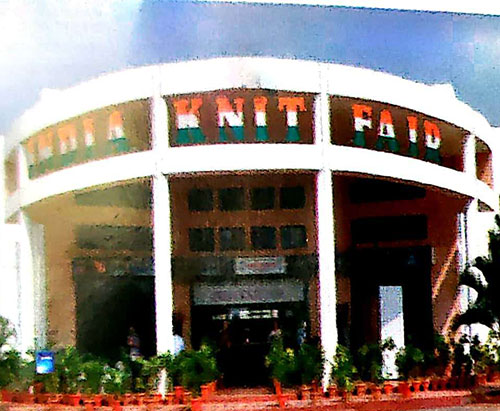
India Knit Fair Association is conducting India International Knit Fair since over two decades instigated with the goal of exporting the competencies/ capabilities of India Knitwear products out of India. The fair aims to showcase the end to end products related to the knitwear sector. The fairs are always held in its permanent complex which has all required amenities and facilities of Global Standards/ norms. It is organised by in collaboration with the Apparel Export Promotion Council Ministry of Textiles to promote knitwear exports to maintain contemporary global quality standards and parameters.
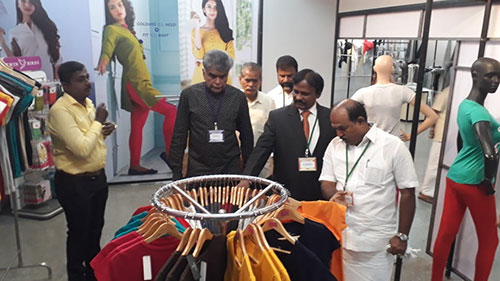
The prominent participants included leading export houses were Poppy's Knitwear, Eastman Exports Global Clothing, SCM Garments, RBR Garments, True Worth Inc.,Clifton Export, N Tex Apparel, Anandhi Texstyles, Kinsley Knit International, Wiseman Exports it also had players like Twin Birds which has diversified to domestic market to stabilize/ derisk business portfolio, etc. What's noteworthy is Tirupur is a big time supplier/ vendor of inner wear to the entire domestic market which was amply domonstrated at some of the prominent stalls; needless to say some of the global brands also source notable innerwear quantities out of this center.
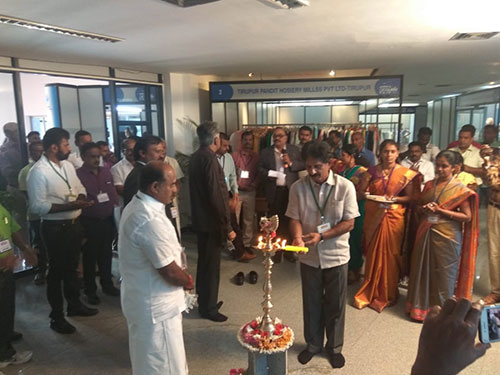
Not only that Tirupur is currently driven by innovations in the new areas like woven side of the garments, new age fabrics, textile digital printing to make it one point solution sourcing destination in the coming years. Additionally some of the industry players here are seriously looking at exploring green field/ brownfield strategic investment opportunities in the overseas markets to go places/ global.

Also supply chain players are there in this exhibition which entailed players like KG Denim, Siruvani Yarns, Filamento local propritory software devolpers, Singapore based group Super Dry Desiccant to add width & depth to this show of repute. There were trade support bodies like NIFT-TEA college of Knitwear Fashion, ATDC Tirupur Center, ECGC Tirupur, Textile Committee,Tirupur to name a few.
The fair offers a unique opportunity of making the direct buyer meet seller in the most conducive business environment helping business nourish and prosper. It shall help achieving great business as around 700-800 global buyers are expected to visit this prestigious fair. Fair organisers have taken pains to invite buyers from all across the world to make sure in this not so great global business environment they spare no stone unturned to help it's garment fraternity.
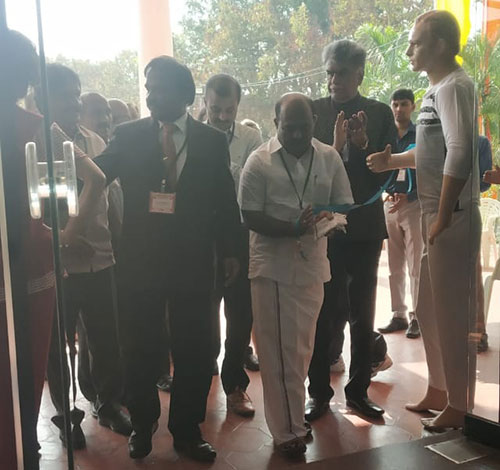
IKFA Help Desk is been set up at the Coimbatore airport to ensure a smooth passage and red carpet treatment for buyer & buyers' team to this mega fair.
What further gives the heart is when world is faced with slow down situation and China faces economic headwinds out of the outbreak of Coronavirus in the short to midterm. Though general trade view is that Tirupur is likely to gain out of this global supply chain disruption only in limited ways as Indian apparel industry continues to face the biggest challenge of lacking the scale and speed to market. So in this given scenario the fairs like IIKF have a vital role to play.












